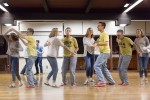Daily Bruin columnist Christi Carras’ limited dance background consists of bingeing episodes of “So You Think You Can Dance,” grapevining her way through high school show choir and stumbling through rehearsals at a daycare-like dance studio until the age of 8. As a personal experiment, she attended workshops and lessons for 10 campus dance groups fall quarter and documented her experience as a nondancer for Dance Break.
1920s fringe dresses and a jazz band with a blaring horn section at a Gatsbyesque party are the first images that come to mind when I picture swing dancing.
In reality, I learned my first Harlem-style swing dance from a fellow undergraduate student who was wearing a Chewbacca jacket.
Leah Phillips, a second-year physics student, lost a bet to a fellow Swing Dance Club at UCLA instructor that required her to wear the furry accessory for the first half hour of the club’s Nov. 27 swing lesson, which was as casual and carefree as its teachers’ “Star Wars” shenanigans.
While the swing atmosphere in the UCLA Sunset Canyon Recreation Center Vista Room wasn’t exactly a Gatsby party, I wasn’t too far off my assumptions as far as the time period went. The earliest type of American swing dancing was the “cake walk” – a style created by enslaved African-Americans mimicking ballroom dancing – and the Harlem-style lindy hop, which rose to popularity in the late ’20s and ’30s, Phillips said.
The six-count Harlem-style dance began relatively simply but later became more complex. The number kicked off with a “rock step,” rocking backward on my right foot, which then launched into two “triple-steps,” which were basically shuffles forward beginning, again, on my right foot.
Thanks to the repetitive cadence that matched “rock-step, tri-ple-step, tri-ple-step” syllable by syllable, the rhythm of the steps was intuitive. However, once we linked arms with our partners to perform the fundamentals full-out, the movements became slightly more nuanced.
Though the rhythm of the footwork remained the same, the lead dancers simultaneously had to push and pull their followers toward and away from themselves, as well as in and out of turns. The added flourishes made me feel like a suave 1920s flapper when I hit them in time.
But when I accidentally turned the wrong direction or stepped offbeat – which occurred equally as often – I threw both myself and my partner off track for at least a couple of six counts. Fortunately for a first-time swinger like myself, the veteran members I paired up with were happy to guide and correct me, free of judgment.
Once Phillips and her partner demonstrated the brief combination in its entirety, they took a break to pace around the room as we practiced, stopping to answer questions and point out small ways in which we could improve our positioning to make the dance more fluid. I occasionally struggled to rock step or triple step on the correct foot while performing a turn, but I found the steps easier to cement in my muscle memory after some one-on-one coaching from Phillips.
After some more practice, Phillips cleared the floor for the social dancing portion of the workshop, which followed a “snowball” framework. For the snowball, we all circled up around one center pair who began the dance when the music started.
When it came time for the routine to loop and begin again, each member of the pair left and grabbed another partner from the circle until eventually everyone was paired up and swinging.
The snowball provided the perfect amount of organized chaos to showcase my imperfect but nonetheless enjoyable new swing steps. Now all I need to do is find a time machine or a ’20s-themed swing club to live out my lindy hop dreams to the fullest.
As Dance Break comes to a close, I cannot claim to have vastly improved my dance technique, or even my basic hand-eye coordination skills – I still can’t touch my toes, and I doubt I’ll ever be able to body roll with as much vigor as Channing Tatum or pop my hips with as much sass as Kim Chung-ha.
But what I do know with reasonable certainty from my 10-group sampling is that no matter the style, culture or level of difficulty, learning a new dance is a hands-, legs- and feet-on opportunity to learn about one’s own physical capabilities and about others’ art and history.

Ayyy, Kim Chungha is mentioned, cheers!